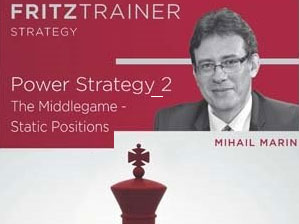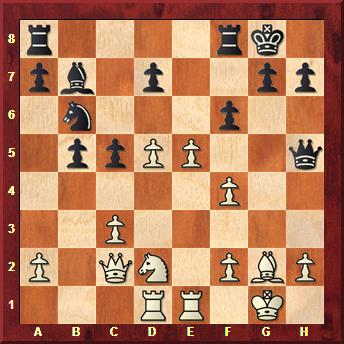


 Mihail Marin’s Power Strategy 2
Mihail Marin’s Power Strategy 2Mihail Marin’s Power Strategy 2 – The Middlegame – Static Positions (Chessbase DVD) is another one that elicited a violent ‘What??’ reaction! It came during Marin’s explanation of the game Drasko-Timoshenko, Tallinn 1989.

Here Marin recommended the move 23.Ne4, which is fair enough. After 23...Bxd5, he recommended 24.Nxf6+ gxf6 25.Rxd5 Nxd5 26.Bxd5+ Kh8 27.Bxa8 Rxa8 with a complicated position. After 23...Nxd5 he said ‘Similar variations are possible. Actually White can start with 24.Rxd5 Bxd5 25.Nxf6+, which is more or less the same thing’. Even with a few glasses of wine inside you, it takes a fraction of a second to spot that 23...Nxd5 loses to any number of moves: 24.Nd6, 24.Nxc5, 24.Qb3 and the list goes on. It’s a strange oversight for a player of Marin’s class.
By this stage I was getting a little bit worried because I had been having problems getting into the opening couple of games of the DVD. Somehow, I found it hard to get a grasp of which theme precisely Marin wanted to talk about and I found my attention wandering. Just in time however, Marin got into his stride and the next series of games were of the high quality we expect of him. I’m not at all familiar with the Karpov-Kortchnoi Baguio 1978 match, so it was very interesting to see some examples from this match, and his comments to the Karpov-Gligoric game, a fantastic Breyer System from the 1973 Leningrad Interzonal, were superb.
So what theme was Marin talking about during the Drasko-Timoshenko game? He called it the theme of playing with stable pieces – usually a knight – which are placed on a stable and well-protected square. It was a theme which he associated with the Soviet Chess School. Marin’s point was that both the knight on b6 and the bishop on b7 were very stable and placing big pressure on White’s centre. When I watched the DVD, I was rather dubious about this particular example, to be honest – I don’t know how impressed I really am with the power of Black’s minor pieces – but that phrase ‘stable pieces’ has kept resonating in my mind. So much so that I’ve been using it again and again to find moves in analysis! So in conclusion, a slightly mixed experience though the best stuff is really very good!

[Event "Tallinn"] [Site "Tallinn"] [Date "1989.??.??"] [Round "10"] [White "Drasko, Milan"] [Black "Timoshenko, Georgy"] [Result "0-1"] [ECO "E18"] [WhiteElo "2505"] [BlackElo "2460"] [PlyCount "74"] [EventDate "1989.04.??"] [EventType "tourn"] [EventRounds "11"] [EventCountry "URS"] [EventCategory "12"] [Source "ChessBase"] [SourceDate "1996.11.15"] 1. d4 Nf6 2. c4 e6 3. Nf3 b6 4. g3 Bb7 5. Bg2 Be7 6. Nc3 Ne4 7. Bd2 Bf6 8. O-O O-O 9. Rc1 c5 10. e3 Na6 11. d5 exd5 12. cxd5 Nd6 13. Qa4 Nb4 14. e4 Nd3 15. Bf4 b5 16. Qc2 Nxf4 17. gxf4 Bxc3 18. bxc3 Nc4 19. e5 f6 20. Rcd1 Qe8 21. Rfe1 Qh5 22. Nd2 Nb6 23. Nb3 {Marin’s point is that both the knight on b6 and the bishop on b7 were very stable and placing big pressure on White’s centre.} ({ Marin:} 23. Ne4 Bxd5 ({After} 23... Nxd5 {similar variations are possible. Actually White can start with} 24. Rxd5 ({Sadler: "Even with a few glasses of wine inside you, it takes a fraction of a second to spot that 23...Nxd5 loses to any number of moves:"} 24. Nd6) (24. Nxc5) (24. Qb3) 24... Bxd5 25. Nxf6+ { which is more or less the same thing.}) 24. Nxf6+ gxf6 25. Rxd5 Nxd5 26. Bxd5+ Kh8 27. Bxa8 Rxa8 {with a complicated position.}) 23... Rac8 24. Na5 Ba8 25. c4 fxe5 26. fxe5 Rf5 27. e6 dxe6 28. Rxe6 Rcf8 29. Rde1 bxc4 30. Nc6 Nxd5 31. Qxc4 Kh8 32. Qe2 Qxe2 33. R1xe2 Nf4 34. R2e3 Nxg2 35. Kxg2 R5f6 36. Rxf6 gxf6 37. Re6 Rc8 0-1
Order the Marin's Power Stragegy DVD in the NiC Shop or directly from ChessBase

Video: New In Chess magazine is read by club players in 116 countries
|